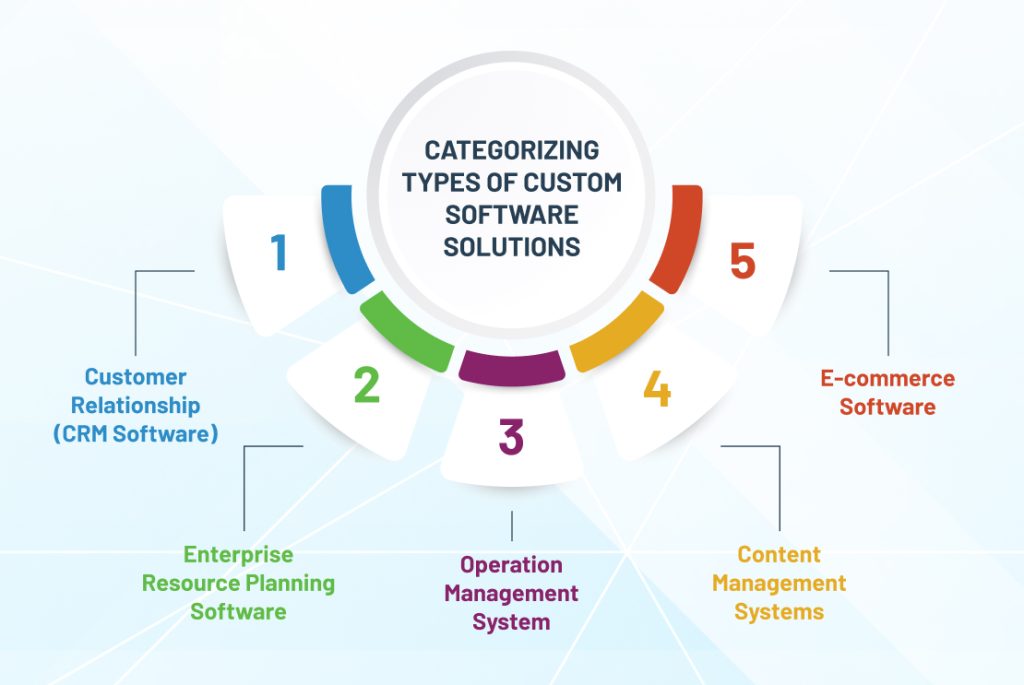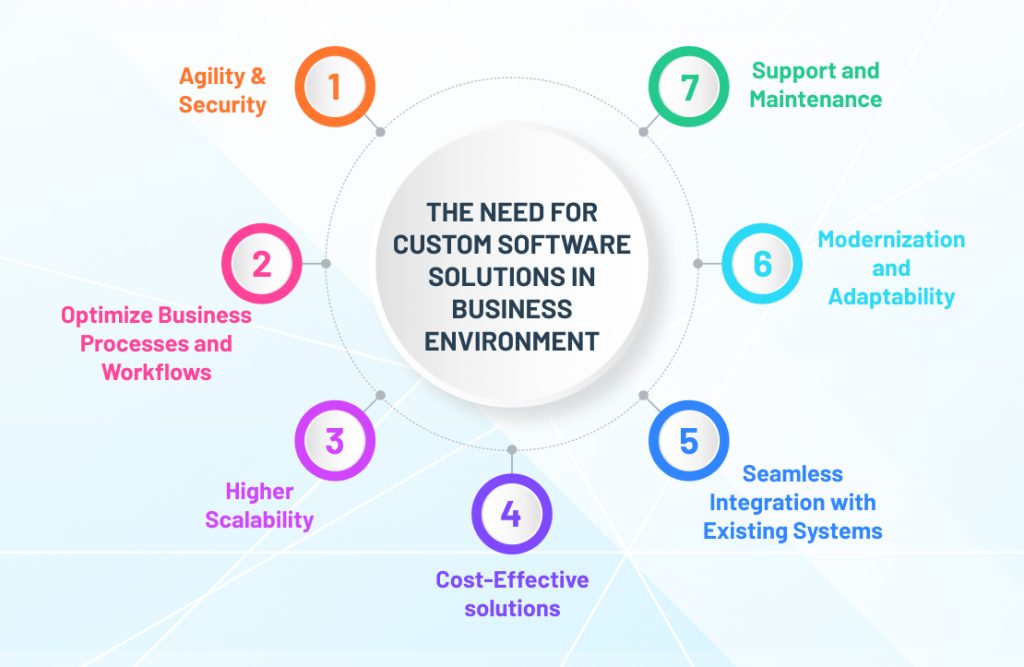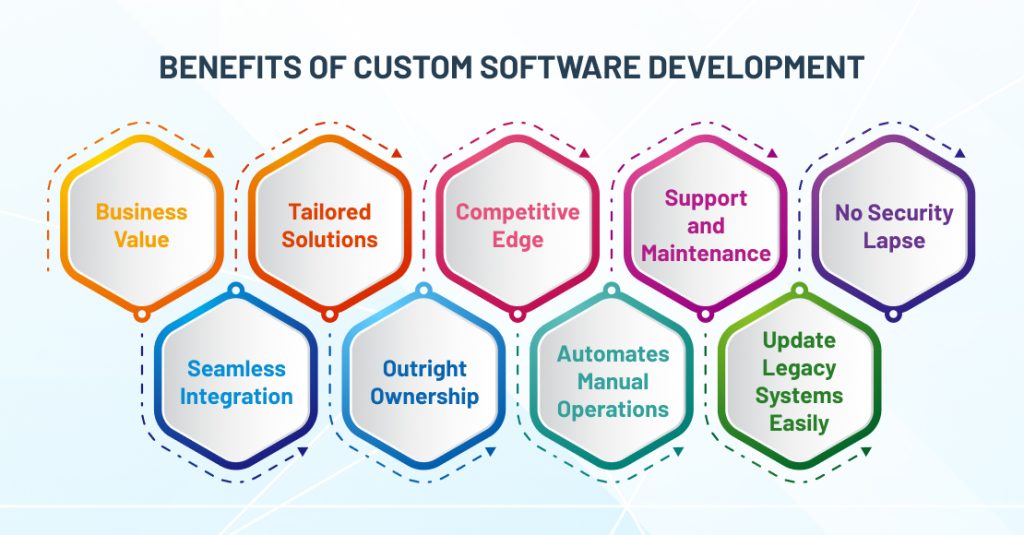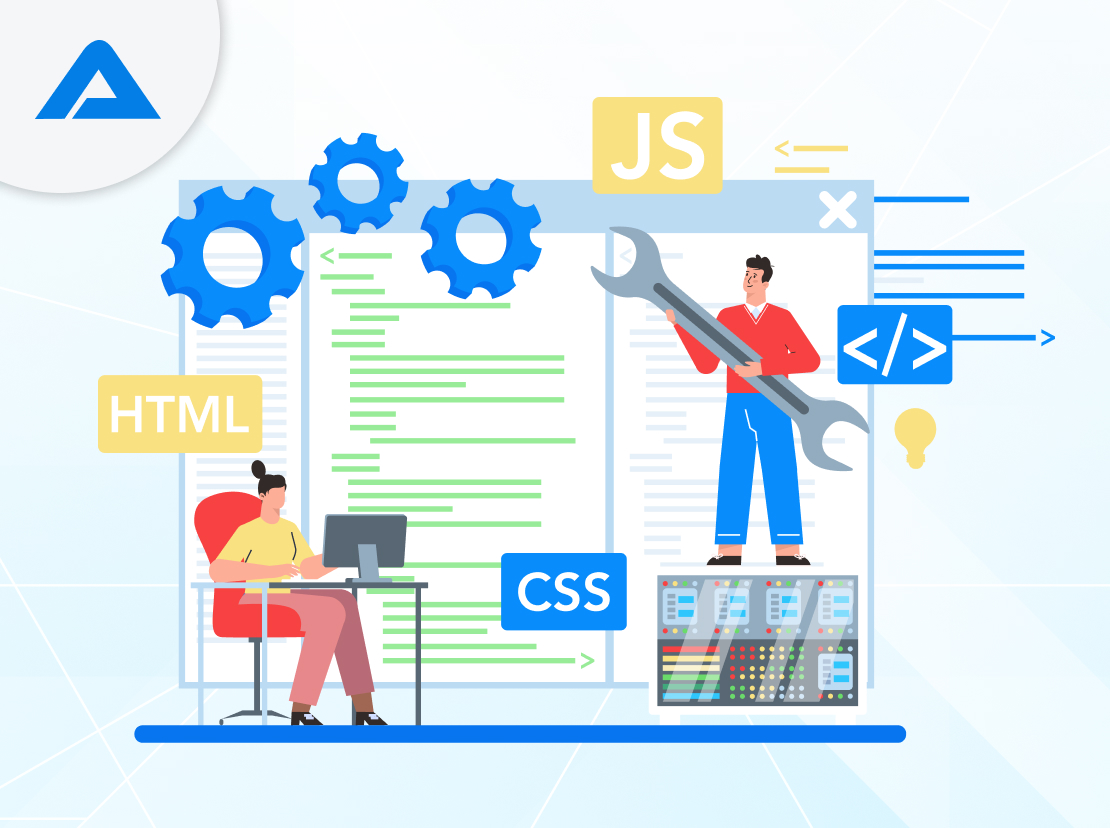Businesses today need solutions that meet and exceed their unique needs. Custom software development services can help. It revolutionizes how companies operate by creating technological solutions tailored to individual user requirements.
According to the latest reports, almost 90% of companies already operate on a digital platform. This trend will only increase as tech giants invest billions of dollars in AI, IoT, and ML.
From 2022 to 2030, the global market for custom software is expected to grow at a CAGR (Compound Annual Growth Rate) of 22.3% and reach USD 24,46 billion. Custom software development involves creating applications tailored to meet specific business needs or personal requirements.
This comprehensive guide will take a closer view of custom software development. Let’s start by exploring the complexities of this concept.
This guide is more than a superficial exploration. It delves into the many layers of expertise, skills, and effort in creating these software ecosystems.
Defining the Term: Custom Software Development
Custom software development process involves the design, development, deployment, and maintenance of technology that is tailored to the needs of your users and streamlines the business process. Custom software is created for specific features, including all functionalities and modules your business needs.
Custom software can also be referred to as bespoke software.
Custom software’s primary objective is to upgrade and scale the technology over time to achieve business objectives, stay competitive, and increase revenue. Custom software development includes the phases of design, development, and deployment.
You may also need custom software if you cannot achieve your business goals with ready-made, packaged, or off-the-shelf software. You can immediately use off-the-shelf software if you choose it. There will also be questions about compatibility.
On the other hand, custom software development is an expensive investment (definitely more costly than off-the-shelf software), and it uses different methodologies, such as Agile, DevOps, or Rapid App Development. Custom software development is the best option for your business.
This article will explain the fundamentals of software management if you’re about to automate your business processes by implementing software.
Categorizing Types of Custom Software Solutions

Companies in all sectors are realizing the benefits of bespoke technology, from improving customer experience to increasing operational efficiency. You can use various bespoke software to accelerate digital transformation and achieve your organization’s goals faster.
Customer Relationship (CRM Software)
Connecting with customers, vendors, and co-workers to build stronger and more lasting relationships. Custom CMR Development Services helps develop relationships, improve sales, manage a department, and ensure smooth business operations. You can design a new system for managing customer relations if you feel the current one does not meet your needs.
Enterprise Resource Planning Software
ERP can help manage the daily activities of any company, from supply chain management to risk and compliance. It is part of an ERP suite that allows the business with activities like planning, finance, and predictive analysis.
Operation Management System
The operation management system is the process and practice of managing a business while maintaining high performance in daily operations.
Content Management Systems
The website will undergo many changes, including adding videos and articles, adding new pages, editing the content, etc. A content management system allows you to make any required changes without writing code. WordPress, Zoomla, and Wix are examples.
E-commerce Software
You can create, manage, and publish a digital site without writing any code. You can customize the keys and functions of E-commerce Software to meet your business needs.
The Need for Custom Software Solutions in Business Environment

You now have a good idea of what customized software is. It’s time to move on to the next step – when should you consider custom software development?
Consider the following cases to understand better why you need custom software.
Agility & Security
Custom software development is capable of integrating as many features and functions as possible. You can use this method to incorporate security parameters that will protect sensitive data and transactions for your business and customers.
If you are looking for feature-rich and secure software, consider bespoke software.
Optimize Business Processes and Workflows
Businesses in the same domain can have very different processes and operations. To be more effective, workflows must be tailored according to the daily operations.
These errors and bugs can cause CTOs problems if handled incorrectly. DevOps is the only way to fix these errors and bugs. You can easily enhance business operations by implementing unique development methods.
It’s time to hire developers who can build custom software if increasing your company’s operational efficiency is one of your main concerns. You can easily optimize your business process with a customized development project instead of replacing specific components.
Higher Scalability
One primary concern is always on the minds of business owners when they build software or websites. Will the software be able to withstand the test of time?
Custom software development is a solution to such problems and unforeseeable challenges. Bespoke software can be future-proofed, allowing developers to incorporate advanced tools.
Cost-Effective solutions
You might have a question about the cost of developing software. How much does it cost to develop software? It may cost more than you think, and you’re partially right. At first, it can be expensive for new businesses. It will be a good investment in the end.
You can easily modify or add functionalities to custom software based on your plans and outcomes. This is a cost-effective option.
Modernization and Adaptability
It’s essential to remain competitive in this business environment that is constantly evolving. Your business will be obsolete if you don’t. Custom software development can achieve this goal by adapting it to market trends.
If you want to boost the value of your business by launching new products before competitors, custom software development is a great way to do it.
Seamless Integration with Existing Systems
In large organizations, different departments are often under the same roof. Integration with other departments in such a situation is complex. This is a difficult task. Compatibility issues are more likely to occur, resulting in lower production and efficiency.
You can integrate multiple systems with custom software development. Custom software solutions streamline the automation of several departments using custom software development.
Support and Maintenance
You will be primarily concerned with managing your customers’ queries if you operate in B2C. With custom software development you can achieve this more efficiently.
You can hire software developers with experience or outsource to a custom software company. They will build custom CRMs that manage security and technical glitches, allowing you to interact seamlessly with the support staff. Outsourcing software development is, therefore, a wise choice.
When you need it, the custom software company will provide round-the-clock support and maintenance for your software.
Benefits of Custom Software Development

Custom software development is best way to improve business processes, customer interaction, and collaboration between departments and partners. Let’s look at the benefits in more detail to see if they’re worth your investment.
Business value
You own the software outright. It’s your Intellectual Property (IP). It is mapped precisely to how your business works or how you want it to work as your organization changes. It is a time-saver, a competitive edge, and a way to retain your unique business features that have made you successful. It’s not just a way to generate value. Custom software is valuable.
Tailored Solutions
Businesses can choose custom software development services to meet their specific needs and workflows. Custom software is built to match the exact business processes. This ensures a better fit and increased efficiency. This customized approach allows businesses to streamline their operations and maximize productivity.
Competitive Edge
Custom software development offers businesses a competitive advantage by addressing business challenges more effectively. Companies can improve their processes by customizing software to meet their unique needs. They can automate their workflows and offer personalized experiences to users or customers. Providing differentiated services and products or differentiating a company from its competitors can help a business stand out.
Support and Maintenance
A dedicated technical staff that can help you create your custom software is a great benefit of custom software development. They are familiar with your software and can help troubleshoot any problems that may arise.
Organizations have different requirements. Most have accepted that generic tools and software will not meet their expectations. Businesses that use tailor-made software can implement innovative ideas and gain an edge over their competitors using generic software.
No Security Lapse
Modern businesses are subject to cyber threats and must be protected with robust security measures. You can trust a custom-made product to ensure data security and smooth business operations.
Software applications tailored to their needs and meet or exceed the security checklists can remain on the market for a long.
Customized software solutions are a great way to ensure the security of your business data. Software built to protect confidential data is only accessible to authorized users. The user will be notified if unauthorized third parties access mainframe software.
Seamless Integration
Many companies rely on multiple software applications to run their business smoothly. Organizations often have to juggle dozens of software applications, from CRM and Business Intelligence to internal communications and finance.
In a world filled with endless tools, seamless integration is essential. Custom software can make flawless integration possible.
Unlike off-the-shelf solutions, custom-developed software can bridge the gap between programs, which offer only limited or no integration options.
There will be no manual jumping between applications, wasted time, or costly mistakes. Data loss is a thing of the past with a customized solution. You are now responsible for your essential information and can make data-driven decisions.
Developers consider how the new software solution will integrate seamlessly into your entire IT environment when creating a custom project blueprint. It ensures that all systems run smoothly and that a solid foundation is laid for future scaling.
Custom software allows you to say goodbye to the headaches of integration and hello to a software ecosystem optimized for your business. Now is the time to unleash your organization’s true potential.
Outright Ownership
What could be more rewarding than owning something for real? Custom-built software gives you complete autonomy. When you buy third-party software, you are essentially leasing it.
According to the End User License Agreement, others can make changes without your consent. Modifications are also restricted.
It can be very inconvenient to your business and cause operational disruptions that are not anticipated. The development of your software gives you unprecedented freedom. You can experiment with the software and sell it to other companies.
Automates Manual Operations
Manually running a business takes time and effort. It could be more efficient, especially for highly motivated enterprises. Custom software can automate repetitive manual actions, allowing team members and business leaders to spend more time on important issues. It makes everything more efficient.
Update Legacy Systems Easily
Software engineers can recode legacy software systems to integrate modern technology to improve efficiency. This will broaden their functionality and keep them at the forefront of the media.
How do you Develop a Business-Centric Custom Software Solution?
Custom software development can be a dynamic and complex process. It requires planning, execution, and continual improvement. Businesses must follow best practices to ensure high-quality software and achieve successful outcomes.
Incorporating best practices from requirements gathering through deployment and maintenance can improve collaboration and create software tailored to your business’s needs.
Specifications and Requirements
The very first step in custom software development is gathering the team to define the project’s scope. Before beginning development, it is essential to consider the project’s goals, the features required, the resources available, and the expected completion date.
It is important to gather relevant data and make intelligent decisions to plan the project scope and develop a working application without incurring additional costs.
Define Clear Objectives
Define clear goals for your custom software project. Identifying and articulating the specific goals and results the software should achieve is essential. Clarity in objectives helps align stakeholders and the development team so that everyone works towards a shared vision. The success of a software program can be evaluated by evaluating its objectives.
Choose the Right Software Development Company
It is essential to choose the right software company for your project. You should select a custom software company with expertise in your industry and the technologies required. Consider their track record and reputation. A reliable partner will be able to understand your goals, offer valuable insight, and work together effectively to deliver high-quality software solutions.
System Analysis & Design
System analysis examines the concept of software development from the perspective of a company executive who is looking to minimize risk. It then identifies ways to improve it.
You are doing a feasibility study to determine whether or not your plan will succeed. You’ll now need to elaborate on the rest of your idea and justify its growth. This stage is mainly for planning the design and development stages.
Development Phase
The development of the program begins after extensive planning is complete. Development tasks are generally divided into sections so that code can be developed as needed.
Developing code in sections allows for more accurate evaluations and reduces interruptions. It is important to use tracking tools to track the progress of your project during this stage.
Backend development is the backbone of web applications. Backend development is responsible for all interactions between the computer and the user that are not visible on the screen.
The backend refers to server-side action. This is where the website works. This code manages user connections, connects the web with a database, and drives the website.
Testing and Quality Assurance
Conducting rigorous testing and quality assurance to ensure the software meets the standards is essential. This stage involves various types of tests, including functional testing and performance testing. It also includes security testing and usability testing. The testers verify that the software performs as expected, is secure, and is resistant to potential vulnerabilities. They also ensure that it provides an excellent user experience. Bugs, issues, and vulnerabilities are reported and fixed to improve software quality.
Maintenance
The process of developing custom software continues beyond the deployment. To keep software secure, efficient, and current, it is essential to provide ongoing maintenance and support. This phase involves bug fixes, regular updates, improving functionality based on user feedback, and ensuring compatibility with new technologies or platforms.
This includes technical support, troubleshooting, and ensuring that the software continues to meet the company’s changing needs.
Tips for Accelerating the Custom Software Development Process
Custom software development helps organizations improve customer relationships, automate internal processes, and simplify working relationships.
How?
The most important thing is to be open to change. Equip yourself with a scalable solution that can be adapted to changing consumer needs. Any firm should focus on increasing customer satisfaction and retention, operational efficiency, and return on investments.
This is one of the key criteria that a brand must meet to stay competitive in the rapidly evolving digital world.
This section will explain how custom software can expedite the development process and meet client needs quickly at a cost-effective price.
Use Cloud Technologies
Almost every business strives to increase the efficiency and economy of its business applications. This is the case. Cloud computing allows you to quickly and efficiently relocate your apps without disrupting the service.
Cloud-native applications are a growing trend among companies. Cloud platforms and technologies are used to migrate bespoke applications into the cloud.
Cloud technology is a great way to save time for application developers.
Related Article: Benefits of AI in Cloud Computing and How It Helps Your Business Growth
Agile Development
Agile software development works on the rapid iteration and testing of software rather than lengthy planning or design phases. It allows for the fastest prototyping possible, which facilitates further custom development.
Agile software development allows for the completion of projects on time.
Client input is also encouraged. It is easy to track the progress of each phase when a project is divided into manageable pieces. It offers two advantages: increased adaptability and scalability.
Key Performance Indicators (KPIs)
You should consider how you can accelerate the software development process. Keep an eye on your actual numbers. For example, the number of things you have crossed off your to-do list.
Focus on the number of jobs completed each day instead of counting how many lines of code were written. Software development speed and cost-effectiveness are always the goals of companies. It would be helpful if you spent less time on reworking and refactoring or in-person meetings. Your product will be successful if you do this.
Custom Software Development Emerging by 2024 and Beyond
Software development will undergo a significant shift due to the ever-changing technologies. To stay competitive in the next-gen world, businesses must keep up with these technological changes. They expect remote operation, automation, faster deployment, and optimized business processes.
We have developed disruptive technologies that will be at the forefront of custom software development trends in 2019.
No-code & Low-code Development
What has changed in the software development process since modern code development practices? Cutting-edge technologies are reducing the workload of coders, making code development easier and faster.
This can be done with no code or low code development. You can develop software applications using minimal coding. Low-code development environments use graphical tools and interfaces to create applications quickly.
Low code development is software creation that allows non-coders to create solutions independently. It allows a team to focus on the significant development tasks.
Software Integration
In the past, a single program was considered sufficient for a company to meet its commercial needs. The technology landscape is entirely different now. Modern technology has brought the consumer’s needs and preferences into the spotlight.
Custom software applications now support external functionality to ensure a smooth and seamless user experience. Custom development has encouraged internal teams to create applications using existing frameworks and codes.
Composable Application
Most businesses use IaC or low-code custom development, two of the most popular modern methods.
We are referring to the concept of a composable app, whereby functional blocks can be separated from the entire application or process.
The application allows any module to be enhanced and decoupled without affecting the rest of it. These applications are capable of being created with greater functionality and purpose.
Agile and composable apps are easier to create and faster to innovate.
Cloud Solutions
Cloud computing has always been and will continue to be a technology at the forefront of custom software development. Modern businesses mainly use cloud technology due to its mobility, resilience, and low maintenance costs.
Cloud-native applications always run on cloud computing platforms. Cloud computing architectures allocate resources to the services that each application uses. This makes it flexible and optimized to work in cloud environments.
Internet of Things (IoT)
IoT infrastructure is a crucial component in software development, and it’s estimated that this market will be worth $639 billion by 2022.
IoT is about creating a seamless experience in customers’ daily lives by connecting intelligent home applications.
IoT empowers various industries to collect, deploy, and analyze huge amounts of data that flows through interconnected devices in diverse applications.
This guide is more than a superficial exploration. It delves into the many layers of expertise, skills, and effort in creating these software ecosystems.
Things to Consider When Hiring a Software Development Firm
This is the most essential part of our guide to custom software development. We will now help you find the best partner to build your custom software.
You can expect the company to take care of your software requirements, such as:
- Custom software development from end to end
- Filling the technology gap with tech experts
- Dedicated software development teams
- Take on an existing software project
The key is finding the right partner to develop custom software for your product. How do you go about finding one?
We have listed a few quick checks that you can do to make sure you are dealing with the right company. Take a look at them all.
Work Portfolio
The next important thing to consider is their work experience. You can then determine what types of companies and products they previously worked with. Their work shows how much experience they gained with multiple technologies. If a company has built similar products, it will know the processes and the scalability problems. They also have a team that can make them.
Team Size
You should consider the size of the company and its team before hiring an outsourcing partner. You can then determine if the company has the necessary team members or an entire team of custom software developer to create the custom software. Before signing any contract, you should verify how many tech specialists are onboarded.
Software Development Process
The software development process is crucial to the success of the company. You should discuss the company’s development process and project management. You need to know the engagement models, software development processes, estimations of time, costs and other factors, reporting, and more.
The Key Takeaway
You need to focus on all business elements that require your attention.
Startups and enterprises looking to expand their product or business should choose customized software development. You can choose from various companies offering custom software development to meet your needs.
We’ve seen that custom software offers many advantages. It’s a strategic decision that offers many benefits, including seamless integration, personalization, flexibility, security, ownership, cost-effectiveness, and dedicated customer support.
It’s not just a tool. It’s also a path to innovation and sustainability. It opens up new opportunities, propelling companies into the future and equipping them to thrive in an ever-changing, dynamic landscape.
